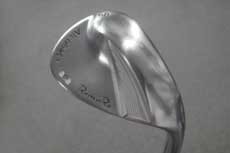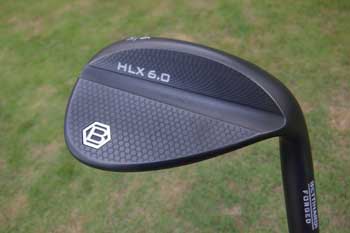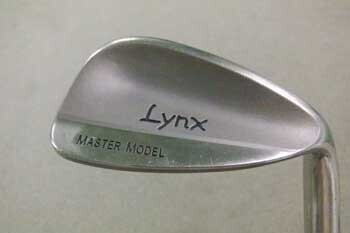Test Review: Cleveland CVX ZIPCORE Wedge

Today, I tested this golf club.
The wedge I tested is the Cleveland CVX ZIPCORE Wedge.
It comes equipped with a Diamana for CGII carbon shaft.
Loft: 58°, Length: 35.25 inches, Shaft Flex: WEDGE, Shaft Weight: 57g, Kick Point: Mid, Torque: 2.9, Total Weight: 416g.

This is Cleveland’s latest wedge release.
When it comes to wedges, Cleveland is a top name. However, it’s been a while since we’ve seen drivers or fairway woods from them, which I find a bit disappointing.
That said, Cleveland is now under Dunlop’s umbrella, and Srixon and XXIO seem to be covering that gap.

The size is standard, but the back face is full of design features and tech elements.
Cleveland’s wedges seem to be diverging into two camps—some models have a clean, flat back, while others, like this one, showcase advanced functionality.
Since wedges and irons often reveal their performance through their appearance, this wedge immediately gives off the vibe of a forgiving, automatic-type club.

The cavity appears fairly deep, with a dark insert inside that gives it the look of a traditional cavity-back wedge.
I’m curious about the function of this dark insert—it’s labeled “ZIPCORE.”

The top line thickness is standard and appears to contain internal structural elements.

The sole is slightly wide, but for a sand wedge, it falls within a typical range.

The sole shape is noticeably rounded and very distinctive.
These days, brands offer a wide variety of sole designs. Some are flat, while others, like this one, are contoured and rounded. That gives players more versatility—depending on the lie, you can manipulate which part of the sole contacts the turf.
Dunlop has become known for its “dual-sole” design, and this wedge follows that trend. The trailing edge has been significantly shaved down, though the bounce remains moderate.
Some players who struggle with bunker shots may actually prefer a wedge with more bounce and an untouched trailing edge—but others will appreciate this type of grind.

The neck is the traditional length you expect in a wedge—a classic Cleveland trait I personally love.
Lately, some wedges have shorter necks, perhaps inspired by modern irons. But I prefer this slightly longer neck—it offers a familiar feel and visual balance.
I do enjoy Vokey and Callaway wedges, but Cleveland’s neck design adds a sense of trust and comfort that really stands out for me.

The face features beautifully milled grooves—precise and clean.
Not all milled faces are equal. Some look rough and rushed, while others, like this one, are finely crafted.
A clean look may not directly impact spin performance, but it definitely makes the club more appealing and confidence-inspiring.
Since the face is the only point of contact with the ball, it deserves close attention.
With irons, I don’t worry too much. But with wedges, I want to feel texture and “grip” when I run my finger across the face—a sense of friction and control.
Compared to a slick, slippery surface, this type of face feels much more trustworthy.
Interestingly, the milling seems to be divided. Near the top line, the grooves are milled horizontally, while the lower part—where contact usually happens—has a circular milling pattern.
There must be a clear reason for this design. Also, the grooves in the lower area appear slightly shallower than those up top.

This wedge comes with a perfectly matched grip—soft and responsive.
It offers a unique, slightly tacky feel that enhances distance control and feedback.
If there were a “sensitivity index” for grips, the Tour Velvet would score near the top in my book.
Maybe it’s because I’ve used this grip for years, but even after trying many others, I keep coming back to Tour Velvet. It gives me that “just right” feel without being too flashy or complex.
When the club feels this good, it makes you want to hit more balls—and that’s how we improve.

At address, this wedge gives off an extremely positive impression.
I initially thought it might look awkward or overly engineered, but that wasn’t the case at all.
It has that classic “Cleveland look” I’ve grown used to over the years.
Despite its enhanced functionality, the clubface looks traditional—a testament to excellent design.
Ease of use comes not just from physical forgiveness, but also from the sense of visual familiarity and comfort. This wedge delivers both.
The slightly rounded leading edge and familiar profile evoke memories of older Cleveland wedges I’ve trusted in the past.
And something unique to Cleveland wedges—the way the head naturally “settles” at address—is outstanding.
Many wedges look good but don’t sit well at address. That hesitation can cause misalignment. Not here—Cleveland wedges always settle naturally and confidently.
It’s like the difference between a rough landing and a smooth one in an airplane. Cleveland gives you the softest possible landing every time.
Test Session Begins

The feel at impact was soft and pleasant.
There was a slight sense of lightness—not “rich” but more on the clean and mild side. Still, it’s very playable in real-world conditions.
The soft feel offered good “ball holding” on the face.

It was very easy to pick up the ball, and the launch height matched my expectations.
The sole glides smoothly through the turf, encouraging you to get under the ball even when slightly fat. Opening the face made it even easier to use and more forgiving.
It handled lob-style shots beautifully with light, high-spinning trajectories.

Spin performance was high and consistent.
I’m sure the milling contributed to this, but the sole grind also played a major role.
In my opinion, a wedge’s effectiveness comes from the collaboration between face and sole—and this one nailed it.
It bites into the ball just enough while exiting cleanly through impact, producing high spin and stability.

Stability is excellent—it’s a true automatic-type wedge.
It may look like a “manual-type” wedge at address, but once you start swinging, the forgiveness becomes obvious.
This contrast between look and performance is one of its greatest strengths—and it doesn’t compromise on feel either.

Because of the good ball contact, distance control was relatively easy.
However, the club felt too light for me personally, so I had to take a few practice swings to dial in my vertical dispersion.
The included shaft is high-quality for a wedge, but I still prefer something with a standard steel weight rather than a lighter carbon shaft.
These days, we’re seeing heavier carbon shafts as well—I’d like to try this head with one of those.
Unlike a driver where you want some “whip,” a wedge benefits more from a firm, stable shaft with minimal flex—more like a solid steel rod for maximum control.
Even though all shafts naturally flex, a soft tip can make precision difficult. For me, the included shaft felt a little too soft and light.
Being labeled as “Wedge Flex,” I was curious to explore what that really means—but I couldn’t quite figure it out through testing.
If it were heavier, I’d consider testing it in my irons too.

Workability was impressive—I was able to experiment with a wide range of shot types.
In theory, your sand wedge should be one of the heaviest clubs in the bag after the putter. But I’ve seen players do well with lighter wedges too.
A friend of mine, who uses only a sand wedge around the green, plays a fairly light one and gets great results.
I tried his wedge once, and it felt too light for me—but this Cleveland might suit him better.
Post-Test Impressions

At first glance, it looked like a typical automatic wedge, and I assumed it would feel awkward at address—but I was wrong.
It had that “manual-style” look that I love—classic Cleveland.

The head size was ideal—not too large, not too small—and the ball sat nicely at address.
Some modern wedges have oversized or unconventional shapes that overpower the ball visually, but this one maintains a nice balance.

This wedge blends a manual-style look with automatic forgiveness—a rare combination.
If I’m honest, I wish the back face design had a slightly more premium or modern feel. It looks a bit plain at first glance.

With irons and wedges, the back face often serves as the first impression—unlike woods where the sole is more visible.
If that initial impression falls short, even good performance might not be enough to fully win you over.
A club has to win your heart first through appearance, then through performance.
In that sense, this wedge’s design could be refined further—but that’s just my opinion.

That said, I’m sure many golfers will love this look—and it’s certainly a practical, game-ready wedge.
It’s highly functional, yet that functionality doesn’t interfere with feel or feedback.
If I were to game it, I’d likely choose a version with a heavier steel shaft like a DG or Modus.
The test model featured a Diamana shaft, but I believe Cleveland still offers steel options, which I’d love to try next time.

Although the term “ultimate” may be used less these days, I’ve long believed that Cleveland wedges come closest to earning that label.
They’re easy to use, stylish, and highly functional.
Truly, Cleveland continues to live up to its reputation as the wedge specialist.
☆ Performance Ratings ☆
Ease of Setup: ★★★★
Feel at Impact: ★★★★
Spin Performance: ★★★★
Launch: ★★★★
Stability: ★★★★★
Distance Control: ★★★★
Workability: ★★★★
※ (Rated out of 100 points)
★1 = 0–20 pts
★2 = 21–40 pts
★3 = 41–60 pts
★4 = 61–90 pts
★5 = 91–100 pts
More Cleveland Club Reviews
More Wedge Reviews
Other English translation articles
Want to read the original article in Japanese? Click here










